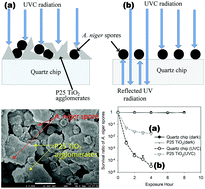For the inactivation of mold spores by UVC irradiation, with ozone acting as a promoter, TiO2 nanoparticles may act better as a “sun block” than as a photocatalytic disinfectant
Abstract
Fungal spores are known as critical indoor allergens, and indoor air purification techniques including photocatalytic disinfection using titanium dioxide (TiO2), ultraviolet germicidal irradiation (UVGI) and ozonation, have been considerably investigated. However, most of the research is in regard to photocatalytic disinfection, focused on the anti-bacterial efficacy of TiO2 nanoparticles (NPs). Furthermore, some research even showed that the photocatalytic antifungal efficacy of TiO2 NPs may not be that significant. Thus, investigating the reasons behind the non-significant antifungal efficacy of TiO2 photocatalytic disinfection and enhancing the antifungal efficacy is indispensable. In this study, ozone was employed to improve the photocatalytic antifungal efficacy of the TiO2 NPs and nano-metal supported on TiO2 NPs. The commercial TiO2 NPs (Degussa (Evonik) P25) served as a good support, and incipient wetness impregnation was successfully exploited to prepare oxidized nano-metals (Ag, Cu and Ni) in this study. There were two surfaces (quartz and putty) used in the inactivation experiments of Aspergillus niger spores which were manipulated under two conditions: exposed to ultraviolet (UVC) light , and exposed to UVC and ozone simultaneously. The SEM images demonstrated that the spores were sheltered from UVC light in the microcracks between TiO2 agglomerates. When irradiating with UVC, the A. niger spores on the two testing surfaces, without TiO2 NPs, were inactivated faster than those with TiO2 NPs, implying a “sun block” effect of this material and a lower photocatalytic antifungal efficacy than UVGI. On both surfaces, the inactivation rate constants (k) of A. niger spores exposed to UVC and ozone simultaneously (on quartz: k = 2.09–6.94 h−1, on putty: k = 3.17–6.66 h−1) were better than those exposed to only UVC (on quartz: k = 1.80–5.89 h−1; on putty: k = 2.97–3.98 h−1), indicating ozone can enhance the UVGI antifungal efficacy.


 Please wait while we load your content...
Please wait while we load your content...